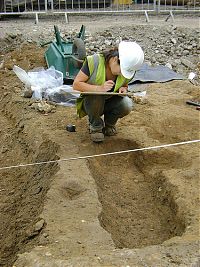Time is Running Out
- By: Elisabet Schager |
- Sep 05, 2008
- Share
- del.icio.us

As you probably have guessed already from reading my fellow colleagues blog entries, the time is running out for us here on site. September out, and some more and that’s it! I have mixed feelings about that, but maybe I should write about that later, when I have my thoughts are a bit more collected…
What I am doing this week is to figure out and then excavate features and layers, all Roman from what it looks like so far. I have to admit, I am confused right now, because it seems that I am in an area where quite a few truncations occur and it is a matter of finding out which layer or feature comes first in sequence. What truncates what??? Which is the most recent one and how does that layer relates to the other one? A bit tricky, but I will sort it out don’t worry. I have a vague idea (am I trying to convince myself here?) how to deal with it. And I have Ashley the genius to help me sort it out if, or should I say when, I’m stuck.
Back to last week so:
That was a fascinating week in many aspects. We came across quite a few really nice interesting inhumations, well-preserved skeletons to investigate. Almost everybody on site, including me, were working under a great deal of pressure, basically under the whip, trying to excavate as fast as possible but trying to be as careful as possible too. I think we did a VERY good job!
The one I excavated was Context: 1719 in grave cut Context: 1720. At a first look at the burial, before I started excavating it, I thought that the cut was a little too narrow to fit a skeleton in.
How wrong I was. He (I think it’s a he from looking at the brow ridge on the forehead and the shape of pelvis, but hey, I’m not an osteoarchaeologist so I could be very wrong) fitted in perfectly in that cut. The arms were crossed over the waist and the legs slightly bent, the head at the east end of the grave. The bones were fairly well preserved. No grave goods. I had to excavate it as quick as I could because of the place in the sequence it had. Other burials were below Context: 1719 stratigraphically, and they were also older, so this fellow had to come out first. The grave cut was also in fact truncating a large pit, so for many obvious reasons, it had to be a race against time. Ruth and other people have written about their skellies so I’m not going to do that.
In the end, Friday afternoon, we were very tired, but not broken, may I add. I better head back out on the field again now, work out the relationships between features etc. So that’s all for me for now.
